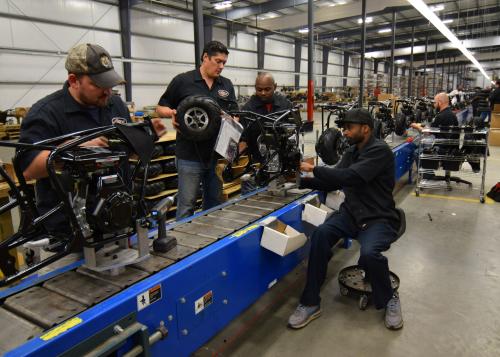This piece originally appeared in The Hill on August 15, 2017.
The most recent jobs report from the U.S. Department of Labor eliminates any lingering doubts that labor markets in the U.S. are now quite tight and that employers need more workers.
The Hamilton Project at Brookings announced that jobs are just as plentiful, relative to the population of potential workers, as they were before the Great Recession. The national unemployment rate, at 4.3 percent, has fallen to its lowest rate since 2001. The job vacancy rate, at 4 percent, is higher than at anytime in recent memory.
Though wage growth is lower than we would like, it too showed some signs of accelerating last month. Average hourly earnings increased by 9 cents from June to July, which, when annualized and compared to the previous month, equals a 4-percent rise.
Stories abound on the difficulties employers have finding and keeping workers in a range of sectors. Employers struggle to fill well-paying jobs in healthcare, advanced manufacturing, informational technology, construction, transportation and logistics with workers sufficiently skilled to handle the work. Workers with wages too low to join the middle class could now have an opportunity to improve their earnings capacity in these jobs.
The most recent jobs report from the U.S. Department of Labor eliminates any lingering doubts that labor markets in the U.S. are now quite tight and that employers need more workers.
Too many workers are on the sidelines altogether, having left the job market in recent years. Some have too few basic skills or work experience to be job ready. Many have criminal records or opioid dependencies that limit their employability. Too many others rely on disability insurance or other income transfers as jobs go unfilled. We might be able to get some of them into jobs now as well.
A tight labor market creates unusual opportunities for us to address these many challenges. Because employer demand for workers is now so strong, the usual questions about whether jobs really exist for better-skilled or more motivated workers are moot. In addition, employers who experience unusual difficulty hiring or retaining workers will likely be more open to training them and perhaps will hire more marginal applicants whom they would not otherwise consider.
Indeed, tight labor markets do more to help disadvantaged workers than any policy interventions, and such policies will likely be more successful when markets are tight. After so many years of slack labor markets, with limited employer interest in such efforts, we must not let this opportunity go to waste.
So what should we do?
First, we must make it a top national priority to engage employers in efforts to train more workers to fill well-paying existing jobs that do not require four-year college degrees. Programs based on partnerships between employers in key sectors and training providers like community colleges should expand their classroom capacities and engage more students as they face high demand.
Work-based learning models like apprenticeships should be especially appealing now to both employers and workers, and public efforts to expand them with tax credits and technical assistance should ramp up.
Second, stronger efforts must be made to engage workers with stigmatizing characteristics, like criminal records and long-term unemployment. Some are not currently employable and not ready for real labor market experience. But perhaps employers would now show more interest in those with good basic skills and with non-violent felonies for drug possession who have not reoffended in a number of years and who show some evidence of successful completion of supervised work programs.
Efforts to place such workers in jobs by engaging employers should receive more support and funding increases. Similar efforts on behalf of others with long-term unemployment, and even those with very limited substance dependencies or disabilities, should be made too.
Third, it is a good time to experiment with proposals, at the state or local levels, to reform disability insurance and other transfer programs by encouraging more employment and training among their recipients.
Those interested in and capable of work would more likely gain work experience now and a foothold in the job market than at other times, as did welfare recipients after reforms in the tight job market of the late 1990s. Those capable of successfully completing community college programs or apprenticeships should be given those opportunities too.
Of course, allowances must be made for those who truly cannot find or keep such work on their own, and important work supports like child care and transportation should be made more readily available. Additional funding needed to assess work capabilities and pay for such support should be provided.
Overall, pragmatic Democrats and Republicans at the state and federal levels should come together to negotiate packages of such proposals, while actively engaging employers and skill providers in the process. It is hard to think of a more promising labor market environment for raising worker employability and earnings capacity than we now have. Let’s not let it to go to waste.








Commentary
Op-edLabor market pump is primed—we must take advantage
August 29, 2017